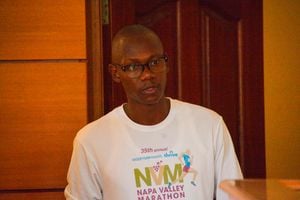We have effective instruments for peace and security in Africa
What you need to know:
Developments in a number of countries are reflective of the recurrent volatility.
- Such protracted conflicts have a debilitating impact on the continent’s development
- It also places a huge strain on the peace-making, peacekeeping and peace building efforts of African states and regional institutions.
The ever-changing and unpredictable global economic scenarios have given rise to the emergence of regional economic blocs as countries and regions seek to cushion themselves against possible socio-economic collapse or stagnation.
However, as countries come together to promote cross-border interactions and joint approaches to international trade relationships, the indispensability of peace and security for the sustainability and protection of anticipated gains cannot be gainsaid.
The global scene has witnessed occasional upsurge of deadly conflicts, paralysing socio-economic stability and erasing gains in various sectors.
RESOURCES
Admittedly, Africa is experiencing conflicts in many regions and these have negatively affected the pursuit for durable peace and sustainable development. It has, of late, experienced an upsurge of the changing nature of conflict — armed intra-state conflicts, terrorism and violent extremisms, election-related disputes and scarce resources-related conflicts, among others.
Development in a number of countries is reflective of the recurrent volatility. Such protracted conflicts not only have a debilitating impact on the continent’s pathways to development but also place a huge strain on the peace-making, peacekeeping and peace building efforts of African states and regional institutions.
Subsequently, mediation, negotiation and dialogue occupy a special place as the most prominent of the tools in the international architecture for resolving conflicts and disputes.
The United Nations’ Sustainable Development Agenda (Agenda 2030) and the African Union Agenda 2063, as well as the AU’s initiative, Silencing the Guns by 2020, are examples of the international normative frameworks for settlement of disputes.
SUCCESS
Success stories include the Burundi situation where the Arusha Peace and Reconciliation Agreement of August 2000, mediated by former presidents Julius Nyerere (Tanzania) and Nelson Mandela (South Africa), ended a civil war that erupted in 1993. The tools played a key role in ending years of apartheid rule in South Africa in 1992 and transition from war to peace in 2000 in the Democratic Republic of Congo.
In the newest republic, South Sudan, the Comprehensive Peace Agreement (2005) was among the frameworks that laid the ground for a negotiated peace deal and transition to independence in 2011. After the post-election violence and disputes between the ruling Zanu-PF and the opposition Movement for Democratic Change (MDC) in Zimbabwe, they were critical in the 2008 Global Political Agreement.
STRATEGY
Here in Kenya, following the intervention of the AU Panel of Eminent Persons, led by former Tanzanian president Benjamin Mkapa and former UN Secretary-General Kofi Anan, a peace deal was reached after the disputed 2007 elections, ending deadly conflicts.
These tools have become key features of the African peace and security architecture. The AU and regional economic communities, including the East African Community, have established infrastructures that support these tools. The AU chairperson often deploys special envoys in situations affected by conflicts and disputes in addition to utilising structures such as the AU Panel of the Wise, established in 2007
The EAC has also put in place several mechanisms aimed at ensuring peace and stability in the region, including a strategy on regional peace and security, a protocol on peace and security, a conflict prevention, management and resolution (CPMR) mechanism and an early warning mechanism.
DIALOGUE
Others include a modality for the establishment and functioning of the EAC Panel of Eminent Persons and for the deployment of special envoys and special representatives, a peace facility (fund).
The technical and experiential expertise required for conflict resolutions, negotiations, mediation and dialogue abound within the EAC with names ranging from retired presidents, vice-presidents, prime ministers and army officers.
We have a chance to tap into this mass of human resource and cushion East Africa against destructive conflicts while also extending a helping hand to our troubled neighbours and friends using the massive powers of negotiation, mediation and dialogue as peace-building tools.
Mr Munya is the Cabinet Secretary for East African Community and Northern Corridor development.





